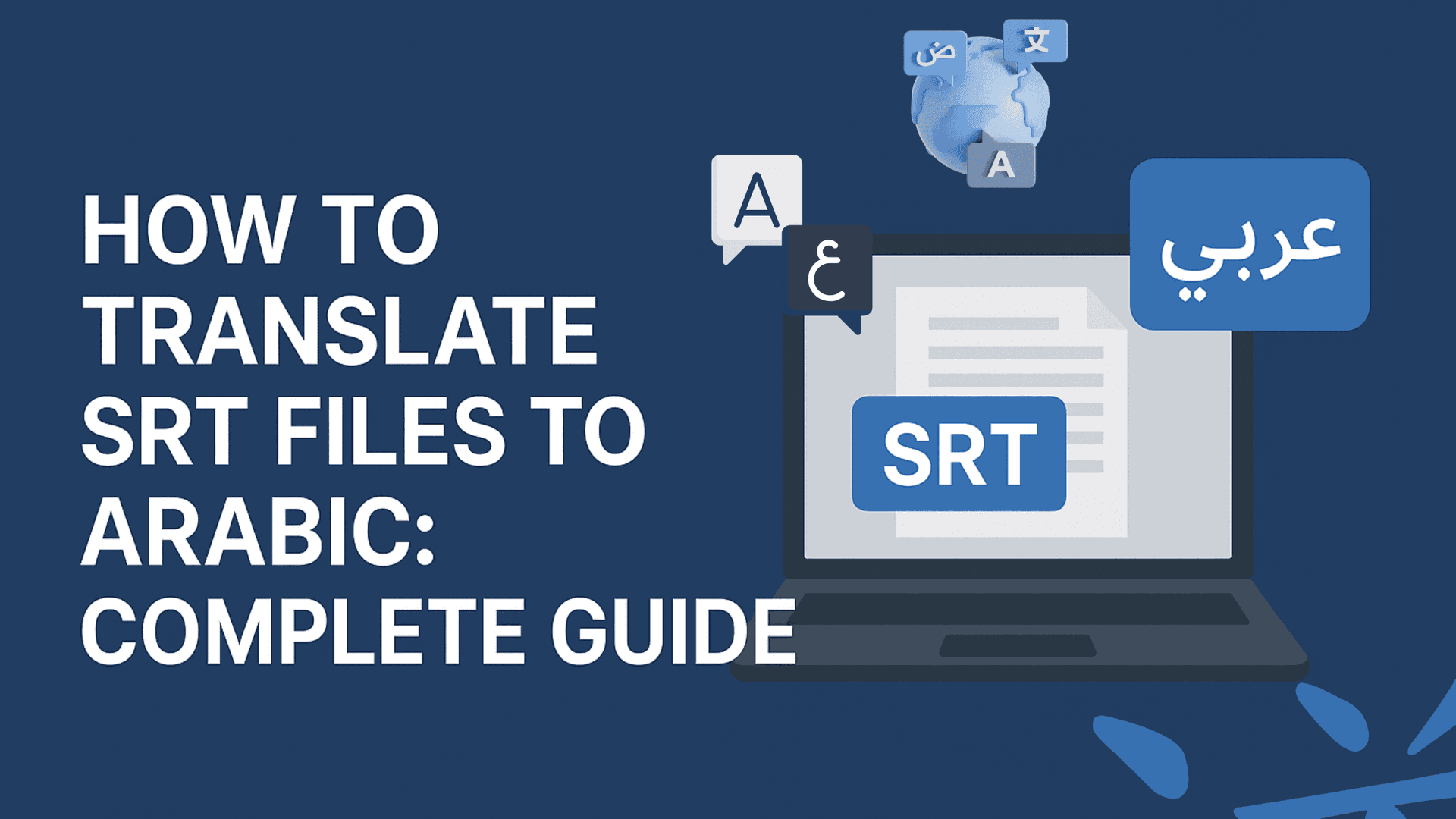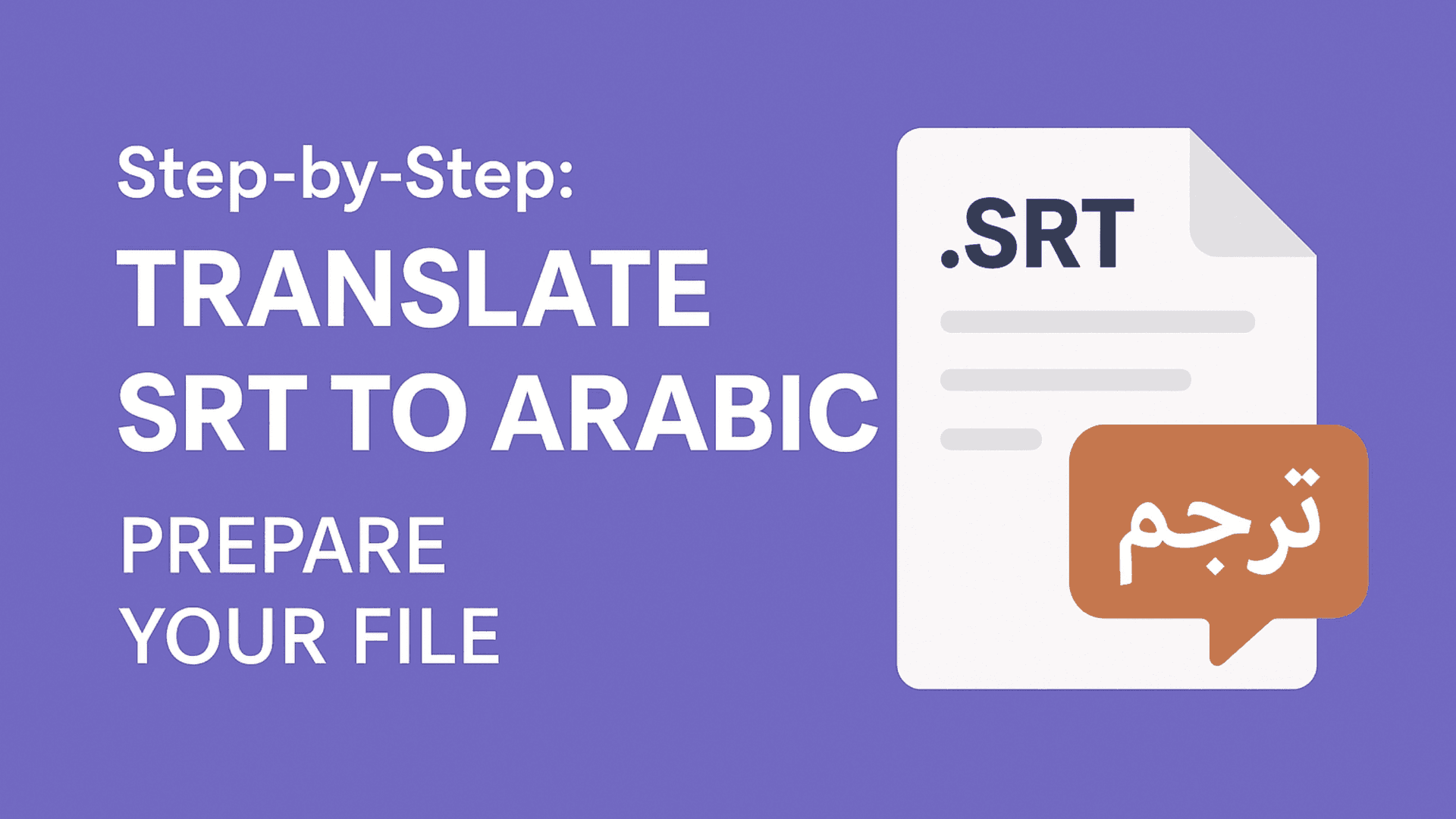
This guide will take you through everything from the basics of SRT files to the translation methods and getting past exact challenges involved with Arabic. Under it all, you will have a clear way of producing your subtitles-high quality, accuracy in valuing, culture sensitivity and engaging audience. Whether making educational content, marketing videos, film and online courses, an effective SRT translate to Arabic process will make larger audience and improve your global positioning.
An SRT file, or SubRip Subtitle file, is a plain text document containing all the subtitles of a video along with time codes showing when a particular line appears and disappears on the screen. It is laid out in such a way that the subtitles are numbered in order and designated with their matching start and end times.
It is this simplicity that makes the format so success. Supported by almost every kind of media player, streaming service and video editing software, this format is thus an easy choice in terms of translation. By translating an SRT file into Arabic, the timing and format are kept intact, while the text gets replaced by its Arabic same. Thus, the same video can be used for different languages without interfering with the visual or audio aspects of the video.
One of the most spoken languages in the world is Arabic. If it SRT is translated into Arabic, then it brings the audience from Middle East, North Africa and beyond. This is a region with very rapid increases in internet entry and an ever growing urge for digital content, yet a population so culturally loyal to brands that speak to them in the local language.
A video is more than images and sounds it is an experience. Following up with audiences in their native languages will make them less likely to drop off mid watch and more likely to interact with your content. A well done SRT translates to Arabic, making your audience feel understood and appreciated, executing exactly this aspect that can translate to more time spent watching, more comments and perhaps more shares.
Not all viewers watch the same video. Some people will have hearing limitation while others would watch with no sound because they prefer it and their environment is noisy. Arabic subtitles meant that your content could be consumed by more people because it now becomes inclusive and accessible. When you convert SRT files into Arabic, you are not just widening your reach but that you are really advocating openness.
One of the less mentioned advantages of using the subtitles is their boosting capacity to the search engine optimization. Whatever is in your SRT file becomes crawlable content, thus allowing your videos to find placement in a search done in Arabic. A proper translation of the SRT to Arabic process acts as a confidence booster that aids discoverability and encourages organic traffic from Arabic users searching for relevant content.

If you, or your team, are proficient in both the source language and the Arabic language, a manual translation of the SRT file to Arabic can be the most correct way. This gives you an opportunity to time and check every single word for its correctness, appropriateness, and culture. Nonetheless, this involves a great amount of work, and the more lengthy the video is, the more it becomes time-consuming.
Web-based applications allow you to upload the SRT file and get an instant translation almost in real-time. This is the fastest way for SRT translation to Arabic however, most online tools will interfere with nuances and tones, making the subtitling judiciously awkward. The best outcome is obtained when machine translation is paired with human translation, i.e., the post-editing approach.
Such subtitling software includes Subtitle Edit, Aegisub, Adobe Premiere Pro, etc. They will provide you a good and simple way to translate SRT to Arabic. These tools give you everything that real-time asynchronous previewing, timing adjustment, character limits, and display for right-to-left writing. They do great justice to long or complicated assignments.
Machine translations can never compare with human translators where it comes to areas like accuracy and cultural nuance, such as in corporate, educational, or entertainment material. The human translator understands idioms, dialects, and contexts that have no equivalent in machinery. Anything good in translation makes your translating SRT document to Arabic very much authentic for a native speaker.
The Arabic Language witnesses writing from right to left. This leads to obstacle creation in cases where the platform or media player does not support this direction correctly. Before publishing, always ensure that SRT translate to Arabic is tested with the appropriate and original format.
Some literal translation schemes confuse the audience or make them feel strange. For example, the idiom 'break the ice' has no equivalent in Arabic, so it must be exchanged with a culturally relevant idiom. A good translator knows when to adapt rather than translate word by word.
Arabic varies widely in dialects, with differences in their vocabulary, pronunciation, and a whole lot more. The common denominator, however, is Modern Standard Arabic (MSA), but not modern standard Arabic that everyone understands within the Arab region, where it largely connects with some audiences. Thus, it depends on the content focus and the target audience to determine which form to adopt.
SRT files to Arabic are different in that they contain visual density as opposed to Latin-based scripts; thus, the average reader may even require a bit more time to read each subtitle. If your SRT translation into Arabic seems a bit rushed, you should, in fact, adjust the display time such that the text is on screen long enough to be read easily and understood. This small adjustment can lead to a considerable positive impact on viewer experience and their overall engagement.
Basic differences will be encountered during the translating of SRT into Arabic, especially where punctuation rules will differ from English. Certain punctuation marks, like commas or question marks, will either be rendered inverted or shift places in the final subtitle file. It is important to ensure the placement of all punctuation and special characters. Mishaps can drastically change meanings. Always test run to view your Arabic subtitles on the intended video player before publishing.
Any successful SRT translation into Arabic will do much more than the traditionally in-your-face translation hunt of SRTs; carefully delivered with the utmost emotional effects in the original language. Whether witty pieces of humor or vigorously motivational lines form part of your content or perhaps even a heartfelt dramatic piece, the feelings must be as well protected as the facts. This is what will ensure your Arabic subtitled version will reach and touch its audience profoundly.
Even when you are translating an Arab-world translate SRT file to Arabic, it is good to remember that the Arab world is culturally diverse. A visual reference or a phrase that has meanings differing in the Gulf region from North Africa may expose your Arabic subtitled content. Swiftly scanning the culture of the region can help in averting misunderstandings, and in the actualization of uncertain feelings within the local audience.

Depending on your budget, timeline and quality needs, select whether to go for manual, automated, or hybrid translation. Manual translation will give you cultural nuance, while automation will provide speed. A fair claim can be made that a hybrid solution will give you the best value for both accuracy and speed.
Change the text only, gut the text of time markers, do not change the sequence number and time code. Keeping the very timing structure will secure exact synchronicity of the translated subtitles with audio-visuals in the video.
Check the grammar, tone and local details ensuring the translation is natural. According to the target audience, verify that not just direct match translation but also idioms, expressions and technical concepts would also have been adapted and will appear very culturally subjective.
Use these wonderful players for example VLC just to make sure that the translated subtitles are unified and well-formatted. This testing would also make sure of catching all display problems, right to left alignment issues, rather misplaced punctuation before publishing the learned content. This can also be done so that you share it later on with primary speakers of the Arabic people for their feedback.
when you translate an SRT into Arabic, make sure to impact further by marketing your videos to any Arabic audience out there. Make sure you post it in trend fashionable captioning and hashtags within the region on some of the great Arab social networking sites Facebook, Instagram, TikTok, and even X. It would be even more effective to work with influencers, vloggers, and content pioneers within the Middle East and North Africa who already have such great audiences to widen your reach. It is important to interact with the comments and answer questions in Arabic while thanking that viewer regarding his feedback to build loyalty and trust among the community.
It would improve YouTube and Google search ranks even further if you would also optimize the titles, descriptions, and metadata of your videos in Arabic. Embedding in Arab-language blogs or forums can create organic traffic for your videos. To maximize reach, run targeted advertising campaigns in Arabic speaking countries, paying close attention to ensure that your message sounds good in their dialect and has cultural relevance, so that it garners maximum engagement and ultimately lends wholeness to your brand identity.
Assuring that your videos are accessible to millions of Arabic-speaking viewers will finally allow you to consider translating your SRT to Arabic accurately and with cultural sensitivity. If you need to translate the SRT of training materials, films, marketing campaigns, or educational content into Arabic, choosing the right way will secure that your message reaches and resonates with the target audience. Visit our landing page, upload your SRT file and get a flawless Arabic translation in minutes.
Translating SRT to Arabic is a bit more than a process; it is a strategic way to touch one of the active language communities of this world. You may go for manual, automatic, professional service and mix translation of an SRT however, the focus is in the aspect of quality and culture. Your workflow process to translate SRT to Arabic may give way to millions of viewers, strong brand presence and truly globalized messaging with the right preparation and attention to detail.